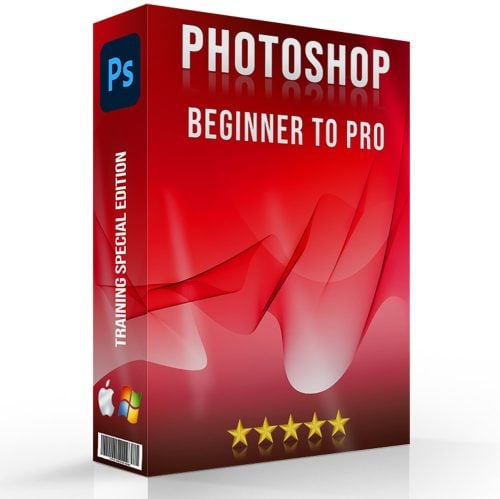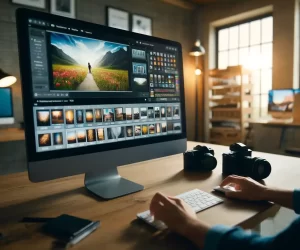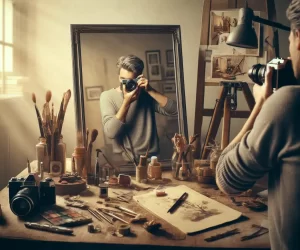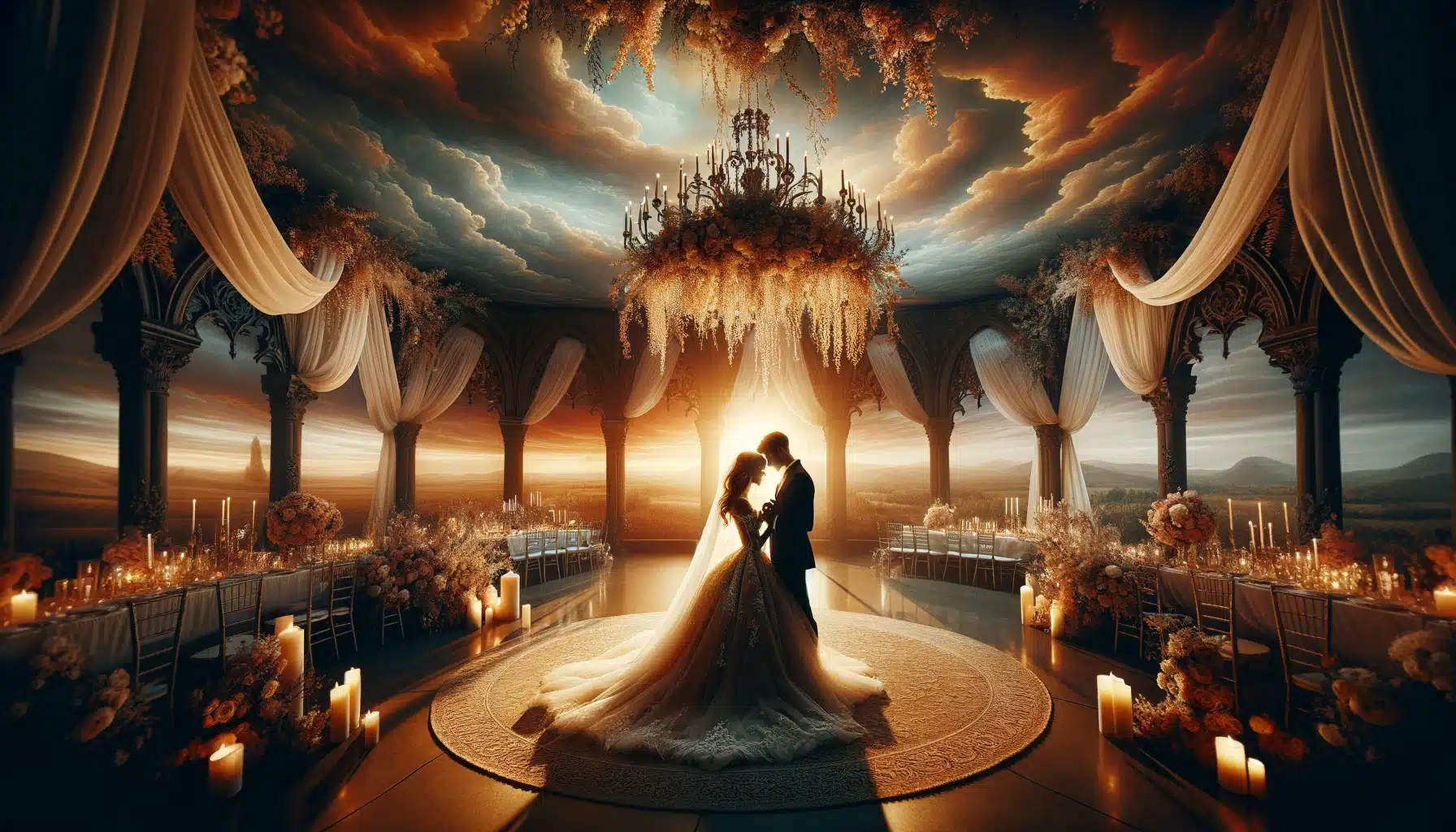
Embarking on the journey of wedding photography can be as exhilarating as the wedding day itself. Capturing the essence of love, joy, and union requires not just a camera but an artistic eye and a heart that resonates with the couple’s story. In this comprehensive guide, we’ll explore the tips for wedding photography that will elevate your skills and help you capture every precious moment with finesse and creativity.
Let’s dive into the world where every snapshot tells a story, and every click preserves a lifetime memory, as one of the most common types of photography.
Table of Contents
Essential Gear for Wedding Day Photography
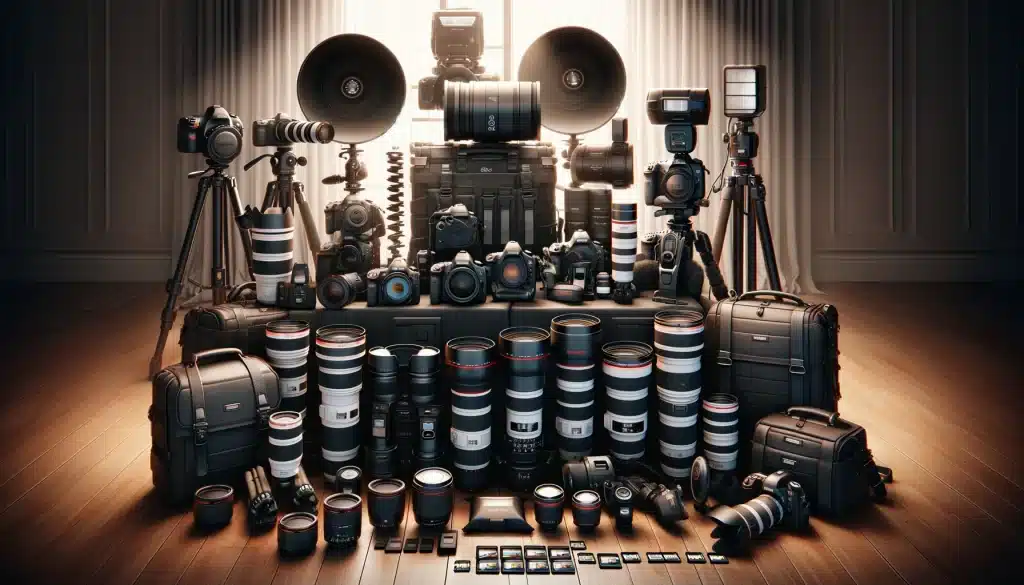
Camera and Lenses for Wedding Photography
One of the primary tips for wedding photography is to carry a camera that’s worth it!
The foundation of wedding day photography gear is a reliable camera and a selection of lenses suited for various situations. A full-frame DSLR or mirrorless camera, such as the Nikon D850 or the Canon EOS R6, is a popular choice among professionals. Key lenses include:
- 24-70mm Lens: Versatile for tight spaces and a range of shots, from portraits to landscapes.
- 70-200mm Lens: Ideal for capturing detailed, far-off shots, creating magazine-worthy images with ease.
- Fisheye Lens: Adds a unique perspective, perfect for capturing expansive scenes and adding a surreal touch to your photos.
Tripods and Stabilization
A sturdy tripod like the Neewer 72.4-Inch or the Manfrotto Element Traveller is crucial for stability and long-exposure shots, ensuring sharp images under various conditions.
Lighting Equipment for Photography
Effective lighting is vital for wedding day photography. Flashes like the Neewer NW-670 TTL, monolights for powerful illumination, and softboxes for diffused lighting are essential to manage various lighting scenarios, especially in indoor or low-light conditions.
Drones for Aerial Photography
Drones, such as the DJI Phantom 4 Pro, add a dynamic layer to wedding photography, offering expansive aerial shots and adding value to your services.
Camera Bags and Storage
Choosing the right camera bag, like the VANGUARD Alta Rise 45 or the Peak Design Everyday Sling 6L, is crucial for organizing and protecting your gear. It should accommodate all your equipment, from cameras and lenses to batteries and memory cards.
Backup Equipment for Photography
Always have backup gear, including an extra camera body, lenses, batteries, and memory cards. This ensures that you’re prepared for any unforeseen circumstances and can continue shooting without interruption.
Post-Processing Tools for Wedding Photography
Efficient post-processing tools, such as Photo Mechanic for culling and Adobe Lightroom for editing, streamline your workflow, allowing you to deliver high-quality images promptly.
Incorporating these essential items into your wedding photography kit will equip you to handle the demands of wedding day photography, ensuring you can capture every moment beautifully and professionally.
Tips for Wedding Photography: Pre-Wedding Preparation
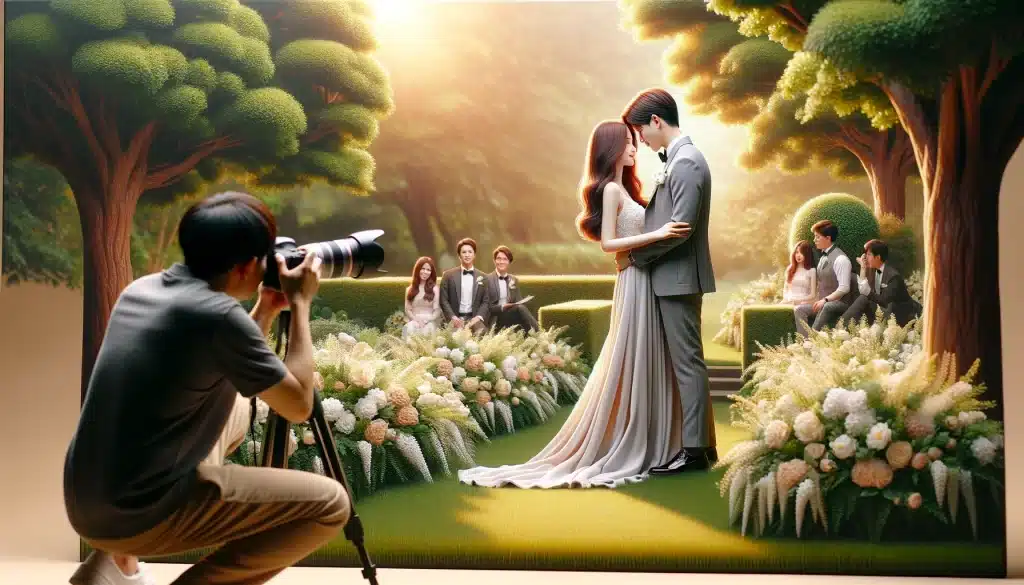
Choose the Correct Kit for the Wedding
For the photographer, choosing the appropriate camera and lenses is essential, particularly for a pre-wedding shoot, where capturing the bride, the ceremony, and the people involved is key. Cameras offering creative flexibility, along with a variety of lenses—ranging from portrait to wide-angle—and essential tools like flash units and reflectors, can significantly enhance the outcome. Don’t forget to prepare your equipment the night before, ensuring batteries are fully charged and memory cards are ready, to meet the clients’ expectations seamlessly.
Think About the Outfits
Photographers should collaborate with the couple and their families to ensure the chosen outfits align with the photoshoot’s location and style. The attire significantly impacts the session’s mood, reflecting the love and connection between family members. Making sure the clothing choices fit the aesthetic of the shoot will enhance the overall feel and result in snaps that clients cherish.
Carefully Select Poses
Guide the couple through poses that feel natural and comfortable. Continuous engagement and reassurance can help achieve relaxed and genuine expressions. Be ready to capture spontaneous moments that often make for the best photos.
Use Movement in Wedding Photography
Incorporate movement like walking or playful actions to capture dynamic and candid shots. This approach helps the couple relax and can lead to natural, joyful expressions.
Capture Candid Moments of the Wedding
Photographers must remain alert to seize spontaneous moments that capture the authentic interactions and love between the couple and their family. These candid shots are sure to enrich the pre-wedding portfolio, offering a deeper glimpse into the relationships and emotions, ensuring clients receive a heartfelt and genuine depiction of their bond.
Have an Assistant for the Wedding
If possible, bring an assistant to help manage the technical aspects of the shoot. They can assist with lighting, handle equipment, or help with posing and arrangement details.
Focus on Details in your Event Photography
Pay attention to small, unique details that are significant to the couple. These elements can add a personal touch to the photoshoot and resonate with the couple’s story.
Incorporate Props during the Wedding
Utilize props that are meaningful to the couple to add a layer of personalization and fun to the photoshoot. Props can help in creating relaxed and natural settings that encourage genuine interactions.
Consider Framing
For great results, photographers should plan to use natural elements like architectural features or trees to frame their shots creatively. This technique enhances the depth and intrigue of the snaps, making the couple’s photographs stand out. It’s all about going beyond the basics and adding that extra layer of visual interest to your work.
Utilize Natural Light
Ensure a great photoshoot by strategically planning to capture the couple in the best natural light, particularly during the golden hour. This timing is key when photographing, as the soft, warm glow will elevate the romantic and ethereal atmosphere of the snaps, making the moments you’re going to capture truly memorable.
Individual Shots during the Wedding
Even in a pre-wedding shoot, individual shots of each partner can add variety to the photo collection, highlighting their personalities and anticipation of the upcoming wedding.
Embrace Playfulness
Make sure to plan for light-hearted, playful interactions during the photoshoot, as these moments will reflect the couple’s unique personality and the dynamics of their relationship. This approach not only results in great photographs but also ensures the session is enjoyable and memorable, capturing the essence of the couple’s bond while going through the exciting journey of photographing their love story.
Tips for Wedding Photography: Techniques for Capturing the Perfect Moments

Utilize Diffused Light
Mastering diffused light is vital, especially in low-light conditions like indoor venues or churches. If flash is allowed, use it wisely by bouncing off neutral-colored surfaces or employ a flash diffuser to soften the light. In no-flash zones, rely on fast lenses with wide apertures and higher ISO settings to manage the low light effectively.
Embrace RAW Format for Photography
Shooting in RAW is essential for capturing the full range of details and allowing extensive post-shoot editing. This format offers the flexibility to fine-tune exposure and white balance, ensuring the best quality in varying lighting conditions.
Showcase Early Shots at the Reception
Creating a slideshow of the day’s earlier shots to display during the reception can add a delightful and immediate element to the celebration. Ensure quick editing of these RAW snaps to highlight the day’s best moments effectively.
Mind the Background for the Photography
Be vigilant about the background in your shots to avoid unwanted elements or photobombers. Scout the location in advance to identify the best spots with picturesque and uncluttered backgrounds that complement the main subjects.
Preserve All Shots of the Wedding
When photographing couples, it’s crucial to plan and avoid deleting snaps during the session. What may initially appear as errors could reveal themselves as artistic or emotionally charged shots upon later review. Embrace the potential of post-processing to discover and enhance these unexpected treasures in your photography, finding beauty in the unplanned moments that capture the essence of the couple’s story.
Alter Perspectives
Adding variety to your shots by changing your perspective can dramatically enhance the visual appeal of your photos. Experiment with high and low angles, and consider unique vantage points to add depth and interest to your snaps.
Group Shots of the Wedding
Don’t overlook the importance of capturing a grand shot featuring all guests. Such snaps not only commemorate the event’s scale but also immortalize the collective spirit of the wedding day.
Master Fill Flash
Outdoor photography can benefit from the strategic use of fill flash to illuminate shadows and balance lighting, especially in strong backlight or midday sun conditions. Adjusting the flash power can prevent overexposure and ensure evenly lit subjects.
Continuous Shooting Mode
Utilize your camera’s continuous shooting mode to ensure you capture those brief, yet significant moments. This feature allows you to take multiple shots quickly, helping you document the event’s spontaneity and ensuring that no crucial expressions or actions are missed. This technique is particularly effective for photographing couples, as it helps to find and preserve the genuine emotions and interactions that are vital for the success of your photography business.
Prepare for the Unexpected during Event Photography
Embrace the unpredictability of weddings by being ready to capture unforeseen moments. These spontaneous incidents often yield the most memorable and cherished snaps, reflecting the genuine emotions and dynamics of the day.
Engage in Fun during the Wedding
Creating a relaxed and enjoyable atmosphere is key for a photographer aiming to capture natural and expressive photos. By interacting in a fun and friendly way, the photographer can encapsulate the joy and spirit of the event, from the bride and groom at the ceremony to the guests participating. This approach ensures that clients receive images filled with genuine moments and emotions, reflecting the essence of their special day.
By incorporating these things and tips for wedding photography, you can enhance your ability to capture the perfect moments in wedding photography, ensuring a comprehensive and memorable collection of images for the couple.
Tips for Wedding Photography: Camera Settings and Techniques
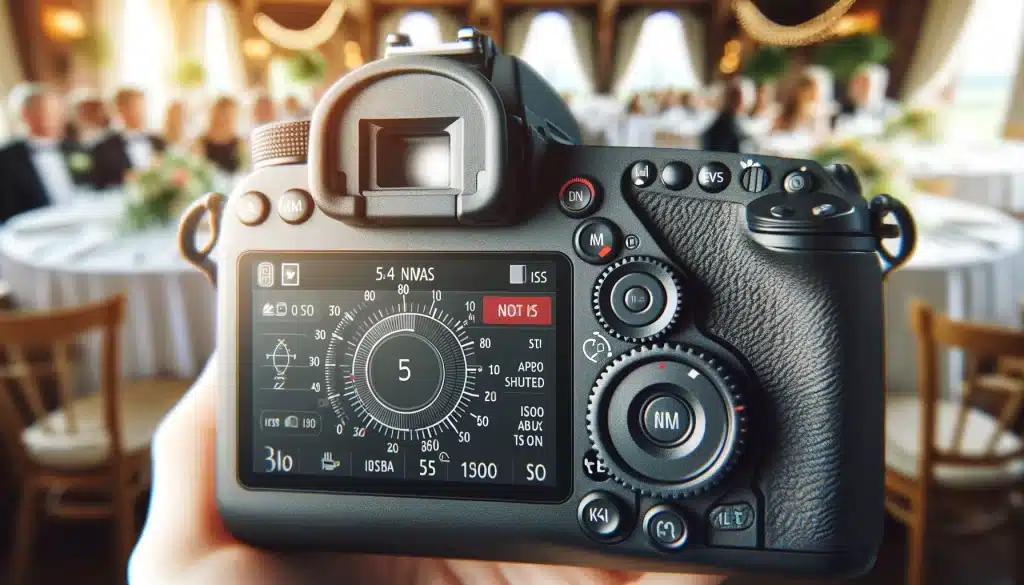
Manual Mode (M)
It offers full control over aperture, shutter speed, and ISO, allowing you to adapt to the ever-changing conditions of a wedding day. Start in manual mode to learn how each setting affects the image.
Aperture (f-stop)
Use a wide aperture (f/1.8 to f/4) for portraits to create a shallow depth of field and a narrow aperture (f/5.6 to f/11) for group shots to keep everyone in focus. This setting controls the depth of field and influences the amount of light entering the camera.
Shutter Speed
For capturing movement without blur, use a faster shutter speed. Around 1/200 is typical, but it may need to be faster in situations like receptions where there is a lot of movement.
ISO
Keep ISO low in well-lit conditions to maintain image quality. Increase ISO in low-light situations but be mindful of the noise level. Modern cameras perform well at higher ISOs, making them more versatile in varying lighting conditions.
White Balance
Adjust white balance according to the lighting conditions to ensure colors are accurately represented. Auto white balance often works well, but shooting in RAW allows for greater post-processing flexibility.
Focus Mode
Continuous Autofocus (AF-C or AI Servo) is useful for moving subjects, while Single Shot AF is better for static scenes or portraits. Choose the focus mode based on the subject’s movement.
Metering Mode
Evaluative or matrix metering assesses the entire scene for a balanced exposure, helping to avoid over or under-exposed images.
Drive Mode
For posed shots of couples, employ the single-shot mode to ensure precision and clarity. When it comes to capturing dynamic sequences like ceremony exchanges or reception dances, switch to burst mode. This approach allows you to catch a range of expressions, things, and movements, helping you find those perfect moments that are crucial for the narrative of your photography business.
RAW Format
Shooting in RAW captures the most data, providing greater flexibility in post-processing to adjust exposure, white balance, and other elements without compromising image quality.
Incorporate these settings and techniques to enhance your wedding photography skills, ensuring you capture every moment beautifully. For those looking to improve their post-processing skills, consider exploring Adobe Photoshop and Lightroom to bring out the best in your wedding photographs.
Editing Wedding Photos for Maximum Impact
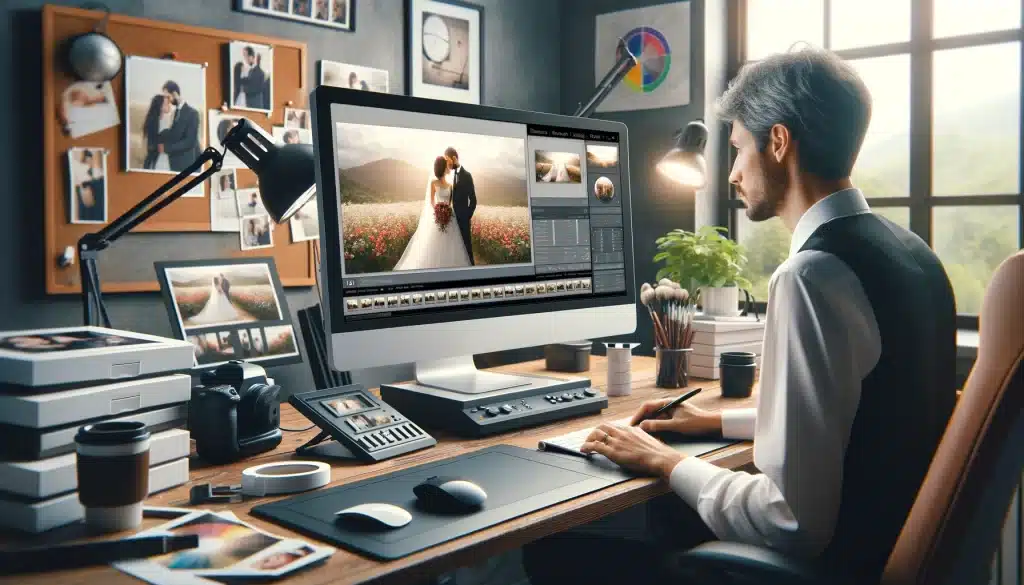
Optimize Your Culling Process in Photography
Before diving into editing, organize and backup your images efficiently. Use AI culling tools like Aftershoot SELECTS to speed up the selection process. This software helps identify the best shots based on emotion, sharpness, and composition, saving you time and ensuring quality in your final album.
Editing Workflow for Wedding Photography
- Manual Editing: Start with a preset that aligns with your style, apply it to your images, and make adjustments. Utilize masks in Lightroom to fine-tune specific areas and maintain a consistent color grading to enhance the overall mood of your photos.
- AI-Assisted Editing: For faster processing, consider AI editing tools like Aftershoot EDITS. These tools learn from your previous edits and apply similar adjustments to new images, drastically cutting down editing time while maintaining style consistency.
Advanced Editing Techniques for Photography
- Photoshop for Major Corrections: Use Photoshop sparingly for removing distracting elements or correcting major flaws. It's crucial for creating flawless images but should be used judiciously to keep the workflow efficient.
- Lightroom for Detailed Adjustments: Utilize Lightroom’s advanced tools for exposure correction, color grading, and noise reduction. Apply local adjustments, healing brush fixes, and cropping to enhance each photo's composition and detail.
Maintain Quality and Timeliness during the Wedding
Ensure that your edits are not only quick but also maintain the high-quality expected in wedding photography. Utilize batch editing for similar images, but be cautious of applying uniform adjustments across varied lighting conditions. Quality assurance should be a priority, with a final review before delivery to the client.
Utilize AI Tools and Continuous Learning in Photography
Leverage AI tools to enhance the editing process, focusing on creativity while streamlining technical tasks. Continually upgrade your skills and knowledge through learning resources, feedback, and guidance, which will refine your post-processing abilities over time. As a photographer, don’t overlook the importance of balancing efficiency with quality in editing, ensuring that the wedding albums you create for clients, from the bride and groom at the ceremony to the people in attendance, leave a lasting impression and stand the test of time.
Common Challenges in Wedding Photography and How to Overcome Them
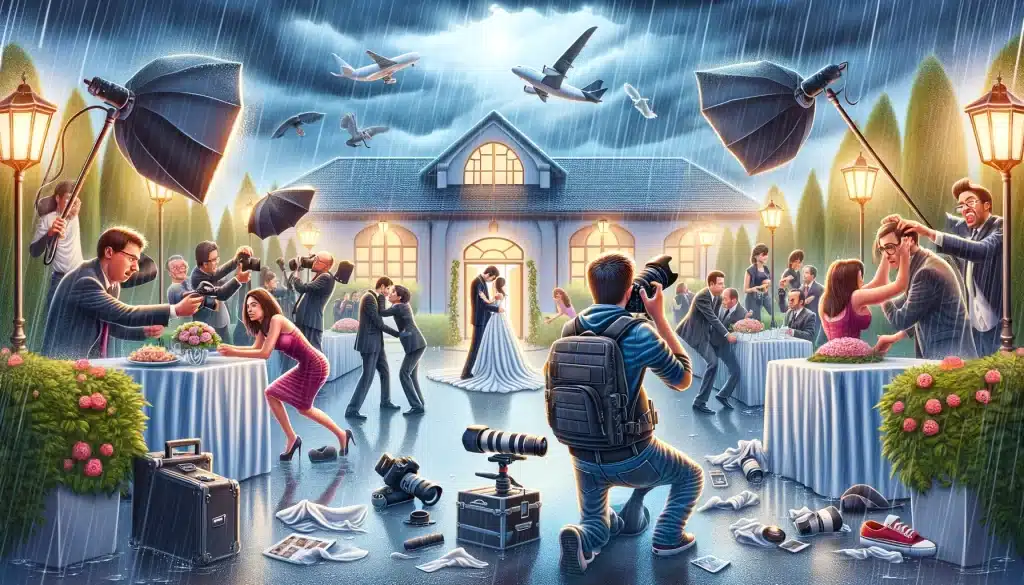
Planning a Wedding Remotely
For international photographers, meeting clients face-to-face can be challenging. Enhance your online presence with professional lighting and camera setup during virtual meetings to make a positive impression.
Dealing with the Unexpected during the Photography
Be adaptable and creative, even in adverse conditions like bad weather or poor lighting. Embrace the situation and explore different angles and compositions to create unique things that will enhance your business and help you find new clients.
Managing Fatigue and Physical Strain
Weddings are long and demanding events. Take short breaks, stay hydrated, and have snacks to maintain your energy. If possible, work with a second shooter to ensure continuous coverage while taking turns to rest.
Gear Accessibility During Wedding Photography
Quick access to your equipment is crucial. Use a camera harness to carry your gear, allowing for easy and fast transitions between different camera bodies and lenses without being obstructive.
Handling Difficult Lighting Scenarios in the Wedding
Challenging lighting, like varying conditions in confetti lines or unpredictable DJ lighting during dances, requires quick adaptation. Test exposures beforehand and collaborate with the DJ to anticipate lighting changes. Use off-camera flash to control lighting and create even exposure on your subjects.
Group Photo Coordination in the Wedding
Organizing large groups for photos can be like herding cats. Assign a family member or close friend of the couple as your assistant to gather people, call out names, and ensure everyone is present for group shots.
Frequently Asked Questions about Tips for Wedding Photography
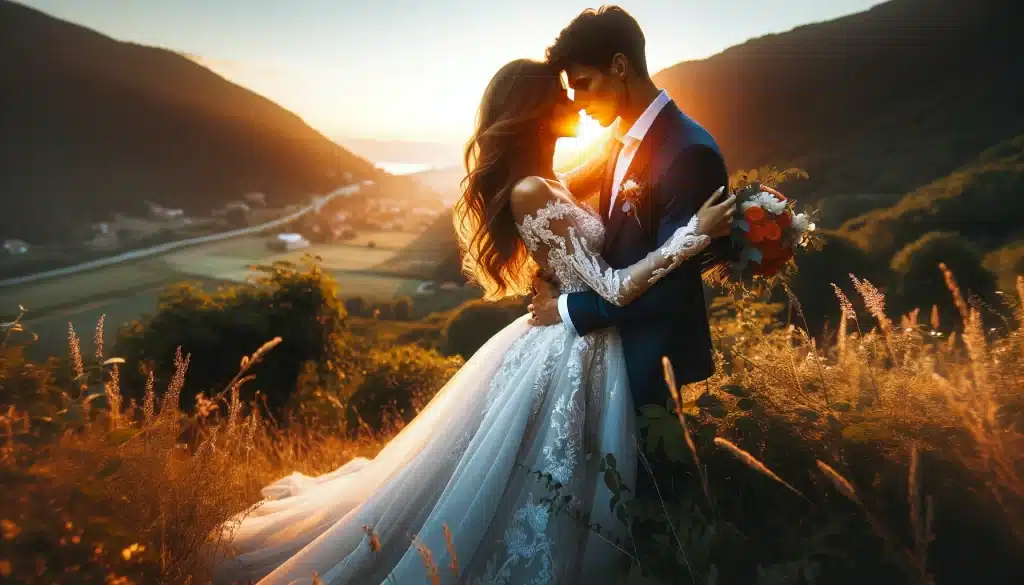
How do you take good wedding photography?
To capture good wedding photography, focus on storytelling, composition, and lighting. Understand the flow of the wedding day, anticipate moments, and communicate with the couple to understand their preferences. Utilize a mix of candid and posed shots, paying attention to background details and expressions. Good wedding photography combines technical skills with the ability to capture the emotions and atmosphere of the day.
How do I look good in wedding photos?
To look good in wedding photos, practice natural poses and expressions before the big day. Engage with your partner and guests genuinely to capture joyful and authentic moments. Consider hiring a professional makeup artist and hairstylist to enhance your features. Good posture, relaxed shoulders, and genuine smiles contribute significantly to looking good in wedding photos.
What are the best camera settings for wedding photography?
The best camera settings for wedding photography will depend on the lighting conditions and the style of the photos desired. Generally, as a photographer, use a low ISO to reduce noise, a wide aperture (f/2.8 to f/4) for depth of field control and soft backgrounds, and a shutter speed fast enough to freeze motion (at least 1/200 sec). Adjust these settings based on the lighting conditions and the effect you want to achieve.
How much do you tip a wedding photographer?
You don’t necessarily have to tip a photographer, but it is a nice gesture if you are pleased with their service. Also, it will boost their confidence. If you decide to tip, 10-15% of the photography package price is a common practice. However, the amount can vary based on your satisfaction with their work, the complexity of the event, and regional customs.
Wrapping Up Tips for Wedding Photography
In my early days of capturing weddings, I faced numerous unforeseen challenges as a photographer, from sudden downpours to last-minute venue changes. These experiences taught me the importance of adaptability and creativity, essential aspects of mastering tips for wedding photography. I recall a wedding where, despite meticulous planning, the weather turned against us, forcing the ceremony indoors. Instead of viewing this as a setback, I embraced it as an opportunity to capture intimate, candlelit moments as a photographer that became the highlight of the album. This experience underscored the essence of wedding photography: it’s not just about capturing events, but about telling a story, preserving memories, and finding beauty in every situation.
For those looking to delve deeper into the art and science of wedding photography, our comprehensive courses in Photoshop and Lightroom offer extensive training. They equip you with the skills to turn challenges into opportunities, ensuring every click captures a story worth telling. Join us on this journey to transform your passion into a profession. I hope this blog will guide you to click amazing pictures of the bride and groom. Even if you make mistakes, don’t be afraid of them, for you will improve with time.
If the “Tips for Wedding Photography ” article has helped you, then Like and Share it with your friends!
Have a nice photoshoot!
Read more about: Photography Techniques
Course
Light Effect Photoshop
Lightroom Course 2024
Adobe Photoshop Course
Photo Editing Course
Get the latest version of Photoshop & Lightroom

